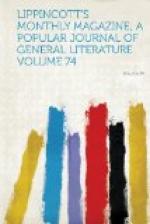Sir, I am bound to admit that this audacious claim spoilt my wanderings up and down the pages of your excellent magazine, and I resolved that whenever I should find time I would write to you to revindicate the claims of the “Berkshire Lady” to be native born and entirely unconnected with the Countess Mary or Slains Castle. I can scarcely remember the time when I did not know the story, which indeed all Berkshire boys—or at any rate all Bath-road Berkshire boys—took as regularly as measles in early youth. But let me explain to New-World readers what I mean by a Bath-road Berkshire boy. Our royal county of Berks is in shape somewhat like a highlow or ancle-jack boot with the toe toward London, and at the tip of the toe Windsor Castle, which, as we all know, looks down on the Thames as it finally leaves the county, of which it has formed the northern boundary for more than one hundred miles. The sweet river—for in spite of all pollution it is still sweet at Windsor—has run all along the top of the boot and down the instep, and along the toes, taking Oxford, Abingdon, Wallingford, Henley, Reading and Maidenhead in its way, with other places historically interesting in a small way over here, but which would scarcely be known by name even in the best-drilled classes of your public schools. Along the sole of the boot, from the heel at Hungerford, but sloping gently upward till it joins the Thames at Reading, runs another stream (a river we call it in little England)—
The Kennet swift, for silver eels renowned.
Now, before the Great Western Railway had opened up the county the only main line of road which passed through it was the great Bath road, which entered near the toe at Windsor and ran along the sole for the greater part of the way by the side of the Kennet to the extreme heel at Hungerford. All the northern part of the county—the Thames valley and Vale of White Horse, and the hill-district which separates these from the Vale of Kennet—was at that time pierced only by cross-country roads, and remained during the pre-railroad era one of the most primitive districts of the West of England. Its inhabitants retained their broad drawling speech, very slightly modified from Tudor times, and looked with a mixture of distrust and envy even on their fellow county brethren in the Kennet Valley, who were being demoralized by their daily intercourse with London through the constantly growing traffic of the Bath road. Along that thoroughfare, besides strings of post-chaises, vans and wagons, ran daily more than one hundred coaches most of which started from Bristol, and made the journey to London in the day. The best of them did their ten miles an hour, and so punctually that many of the inhabitants preferred setting their watches by the “York House.” the “Tantivy” or the “Bristol Mail” rather than by the village clock. It were much to be desired that their gigantic successor would follow their excellent example more faithfully in this matter.




